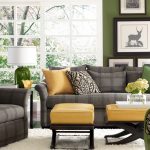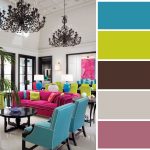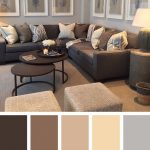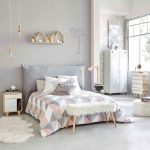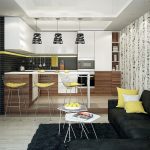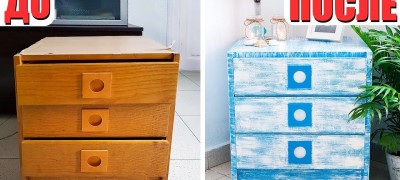How colors are combined in the interior, how to choose furniture to the floor and walls
It has long been known that color can have a certain effect on the emotional state of a person. For example, red can cause feelings of anxiety, while green can cause peace. This is often used by psychologists and designers. The latter especially succeeded in this. So, by choosing the right combination of floor and furniture color, it is easy to make the same room appear darker, lighter or more spacious.
- Combination principles in general
- Influence on a person
- Color circle
- Color combination table
- The combination of neutral warm and cool colors: features
- Color interaction in interior decoration
- Room color and type
- How to match furniture in color to the floor or to the color of the walls
- Examples of color combinations
- Video: features of the combination of colors in the interior
- Examples of color combinations in the interior in the photo
Combination principles in general
When discussing colors, it makes sense to turn to the language of analogies. So, when analyzing shades, we can say that the whole palette is a house in which colors are residents, and their shades are characters. Here, as in life. One is warm, the other is indifferent (neutral), and the third is cold.

How well they get along (combine) with each other and determine the success of the choice of a particular palette. There are several methods to achieve the correct combination. The most popular are two of them:
Apportionment
If you take a certain color scheme (for example, the design of a room), then the entire design is taken as a unit. Further, the main color should be found in six-tenths of the style, three-tenths of the other will be responsible for contrast and attracting attention, and one-tenth of the third will be devoted to accent and shades.

Game of contrasts
This approach is based on the general dualism of things: wet - dry, warm - cold, dark - light. Each color has its opposite. Using this, you can select very interesting palettes. However, you should be careful! For example, dark, warm shades do not "get along" with light, but cold tones.

Influence on a person
The connection between color and the emotional state of a person was known in ancient times, however, only in the middle of the last century a series of scientific experiments began to study this issue. It turned out that the color effect affects the change in the tone of the autonomic nervous system, in particular, on its sympathetic and parasympathetic divisions.
However, certain reactions to color have long been used in design and advertising. For example, red is often appropriate where you want to attract attention, to make an accent. Yellow or orange are considered to be some kind of "antidepressants" that raise vitality and give optimism, while green - calming the psyche.

Important! It should be remembered that color perception is a subjective characteristic, since it depends on the work of the visual apparatus and mental state at a particular moment in time.
Color circle
The color wheel is a scheme that includes the main colors and shades so that it is convenient to find their most harmonious combinations. In the simplest case, this palette looks like this:
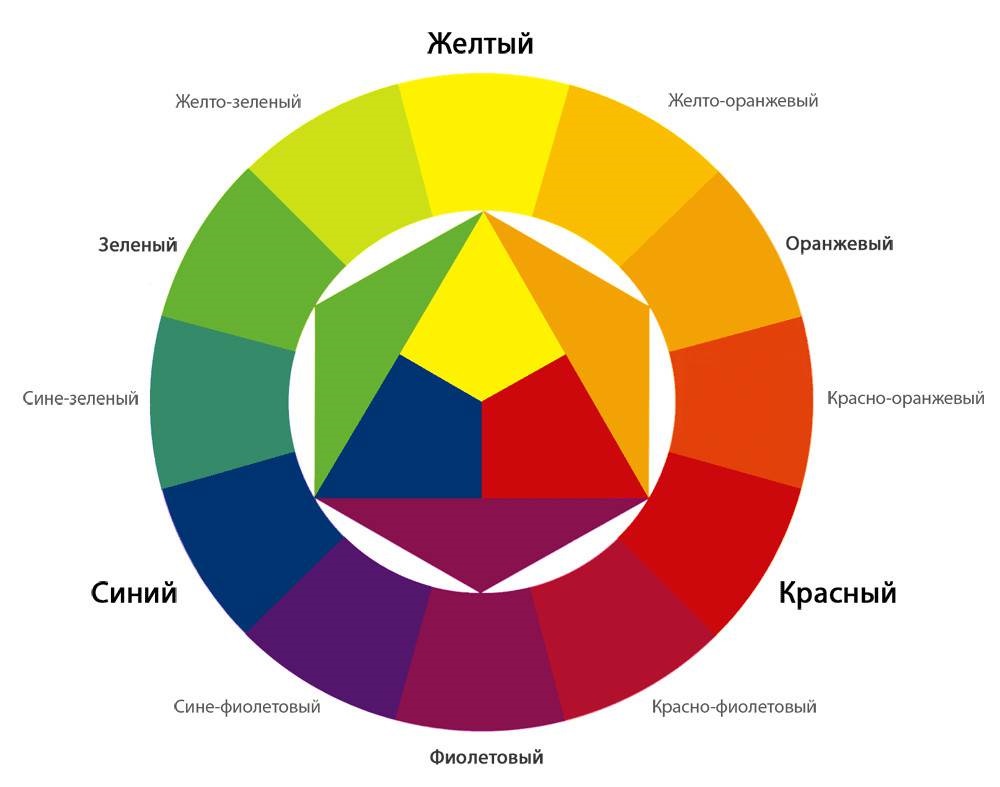
It is known that there are three basic colors: red, yellow and blue. Their combination gives three more: purple, green and orange. By combining the secondary colors with the base colors, you can get six more. Total - twelve. They also form the basis of the above diagram.
When applied to interior design, six sampling options are used, which give the most optimal color balance:
- A sequence of three. A chain of shades following each other at the same level in the same direction.
- Opposites. Two colors on the same circle, but on opposite sides from the center.
- Classic triangle. Equilateral triangle centered at the intersection of the medians. Its vertices will form the color combination.
- Isosceles triangle. The center is in the middle of the greater height. The vertex opposite the base will define the contrasting shade for the other two colors.
- Rectangle. One vertex is selected as the base one. Others let you adjust contrast and saturation.
- Square. A special case of a rectangular circuit. Allows you to get a smoother palette.

Color combination table
As a tool to facilitate the work of an artist or designer, so-called chromatic tables were created, which are palettes of primary colors that allow you to combine them in any way you like, and indicate the permissibility or inadmissibility of such combinations. An example of a table can be seen in the figure:

Additional Information! For starters, you should try combinations of light colors with neutral shades - these options will suit almost any room.
The combination of neutral warm and cool colors: features
In addition to the main definition, each color has secondary characteristics such as hue, tone and midtones. It is the latter that allows us to assert that this shade is warm, and that one is cold. Warm undertones include orange, yellow and red. Cold ones are white, blue, green, and also ... black. Colors are considered neutral, with equal shares of halftones of both temperatures.

There are some techniques for determining the alignment of shades with different halftones. The most important thing to know is that colors with the same half-tones are well combined and, conversely, different half-tones, it is advisable to spread them. However, in the latter case, such combinations are often used for contrast. As for pure white and pure black (sometimes gray is also added here), they combine well with other colors.
Important! The only color that "keeps" a constant temperature is orange! It is always warm and has no cold undertones.

Color interaction in interior decoration
When designing the style of a room, the designer must first of all understand the meaning of each element and its role in the composition. So, if walls are most often the key element, then the door can be used for point contrast or accent, if necessary. However, it may be the other way around - it all depends on the idea.
For furniture
When choosing furniture, one should proceed from the main principle: its color should contrast against the background of the decoration of the room.

For example, a black or white sofa should be placed in rooms with a similar design - it will not draw attention to itself and will not “eat up” the space. For rooms made in neutral shades, it is better to select large furniture in pastel colors, while bright armchairs or chairs should be left for the effect of separation and contrast.
For walls
Since the walls play a key role here, they can be painted, roughly speaking, in anything. It all depends on what kind of emphasis you need to put. Colors of neutral or calm shades should be chosen as a "harmonizer".

Most often, pastel colors are used, they are perfect as a basis for any design solution: furniture, floor, ceiling can be of any color - such a universal substrate.
For floor
The floor tone is chosen in two versions: light and dark. In the latter case, the advantages of such a design are considered to be the possibility of using the same color in any room. In the presence of high-quality lighting, this allows you to clearly accentuate objects. However, you should not put doors of the same tones along with the dark floor.

The floor, made in light shades, is preferable to leave in the bedroom, living room or bathroom, along with pastel walls. Thanks to the better reflectivity, this will make the room a little brighter, and also visually increase the interior volume.
For ceiling
Typically, ceilings are painted in light colors or pure white, while both mat and gloss can be used. This solution goes well with the rest of the color options for both furniture and walls. If you need to emphasize, this is done by placing the appropriate accessories on the floor or hanging them on the walls.

In some cases, it is allowed to paint the ceiling in dark colors. It should be borne in mind here that such a solution will have a positive effect only for rooms with high ceilings (more than three meters). In this case, the floor is necessarily made light. This solution is appropriate for minimalist design, as well as in rooms with panoramic windows.
For interior doors
It is best to choose doors made of natural wood, as it fits into any interior and design. At the same time, it is necessary to understand that the canvas and the platbands should be perceived as one whole, that is, they cannot be separated by color.
White doors are perfect for classic-style rooms. Cool shades, including dark tones, should be applied very carefully - mainly for rooms in a strict, minimalist style. On the other hand, dark doors can be used for contrast when decorating in a neutral color.
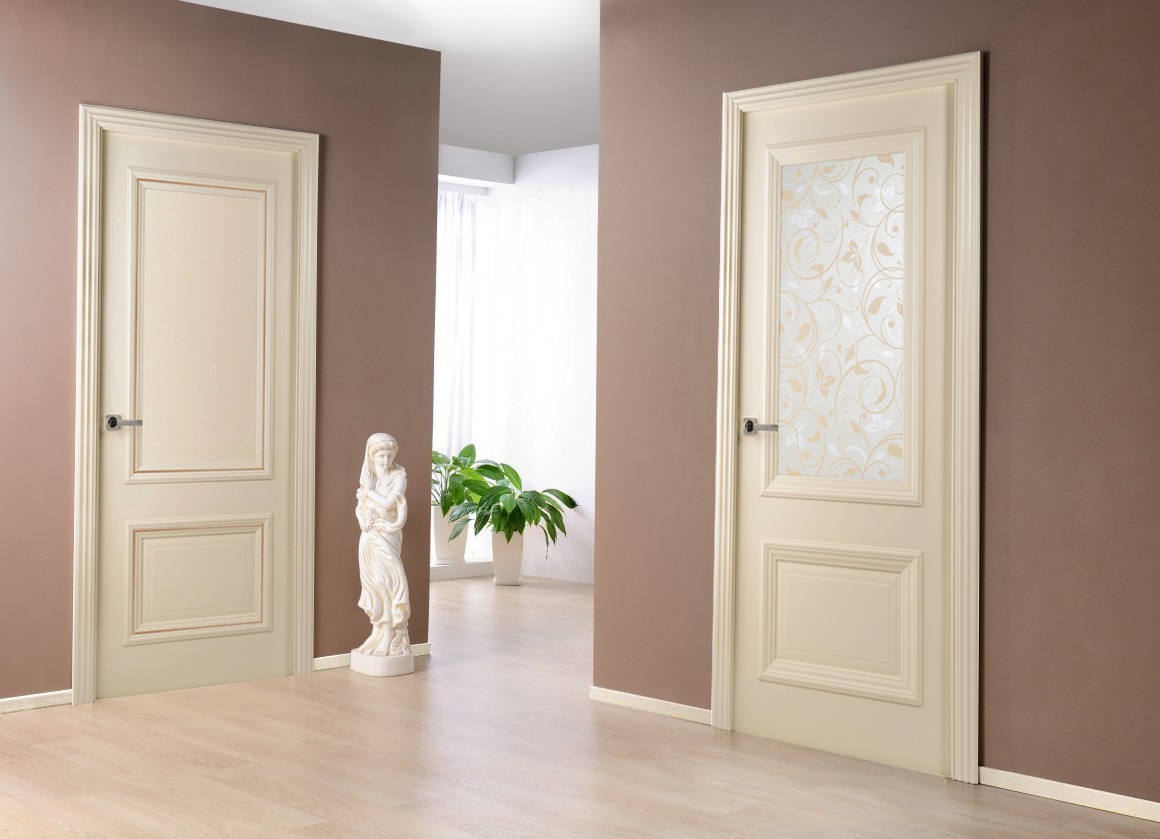
Room color and type
From the point of view of coloristics, the correct selection of the desired colors is influenced by both the size of the room and its purpose (for example, a bedroom or a bathroom). In addition, the setting and lighting are of great importance.
Kitchen
For the kitchen, it is better to choose something from a calm, soft palette. Typically yellow or turquoise, although red may be a good solution. They are believed to "give life" and aid in digestion. In addition, they can be used to place accents or attract attention. It is worth complementing it with a gray, black, white or beige shade.

Living room
In most homes, this room is a concentration of various pieces of furniture (cabinets, hollow niches, etc.) and is often used for different purposes: from the bedroom to the dining room. Therefore, most often the emphasis is transferred to the sofa, which is desirable to acquire a gray or neutral color. However, sometimes they do exactly the opposite.If the room is small, everything is done in cold colors.

Bedroom
Everything here should be aimed at achieving comfort and tranquility. The best option would be a purple shade or something from pastel colors. However, there are successful design implementations with achromatic colors, combined with a play of saturation and halftones. Delicate shades of blue or pink are also good, but it's better to forget about red!

Hallway
This room can successfully continue the monochrome theme. It doesn't have to be black and white. It is advisable to choose a color from the middle of the color chart, otherwise all the dirt and dust from the street will be visible on too dark or too light. It is worth giving preference to beige, green or silver shades. In some cases, they will go well with red.
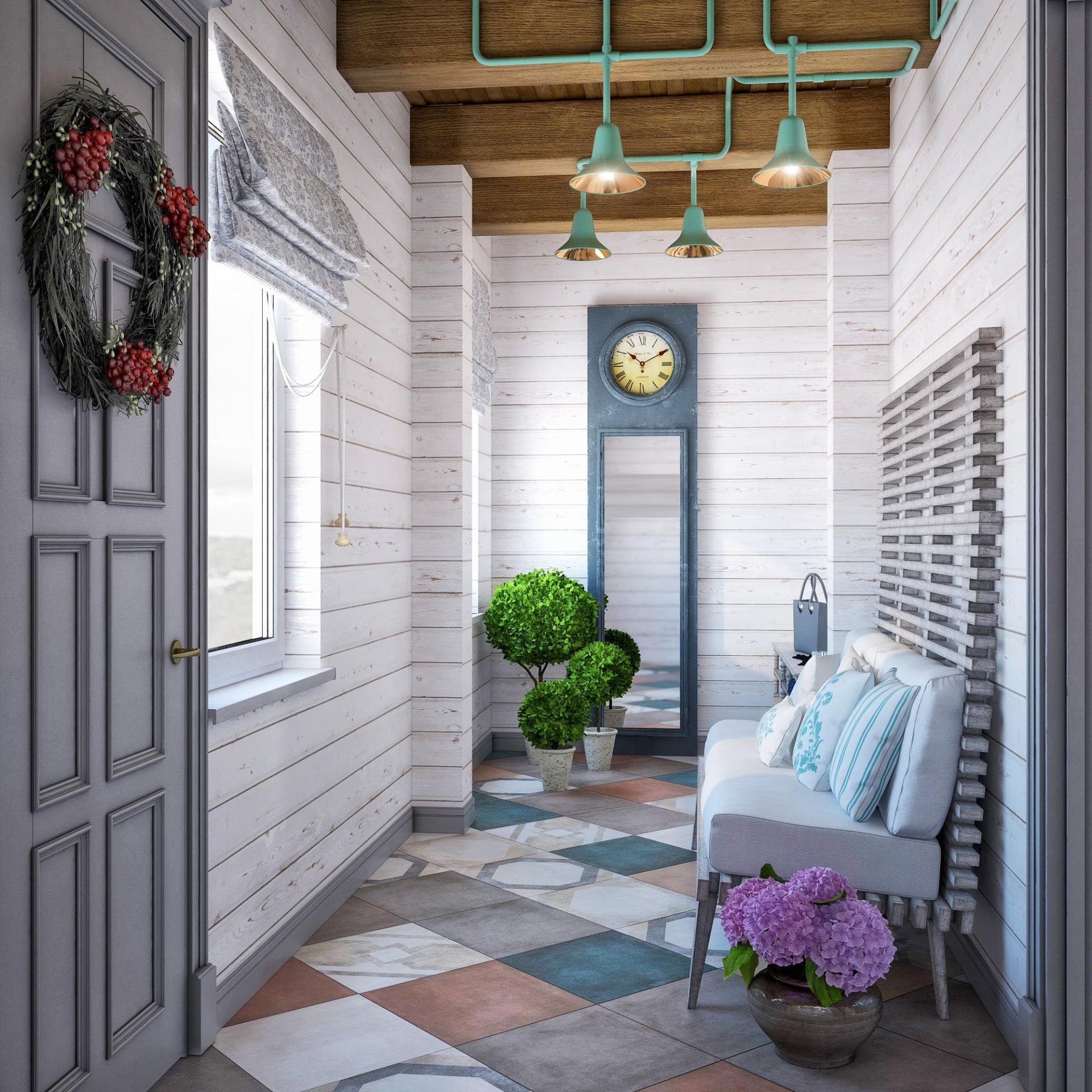
Children
On the one hand, children love everything bright and eye-catching, and on the other, the child's preferences and character should be taken into account. For hyperactive children, it makes sense to design the room in soothing colors.

In addition, solutions based on the play of contrasts are a good option. In such cases, different colors can be used to organize zones: sleeping, playing, working. The main thing is that the color is bright. For girls, it is pink, sand, blue, and for boys, yellow or green.
Bathroom
Usually white or monochrome is chosen for the bathroom - this is due to the fact that designers usually tend to emphasize its cleanliness. Nevertheless, everything is not so simple. In most cases, you can choose any color, up to black. Bathrooms are often found in light green, lavender, pink and even terracotta. Contrast and midtones play a key role here.

How to match furniture in color to the floor or to the color of the walls
The correct selection of the color scheme determines how successful the final interior design will be. All exclusive furniture and expensive materials will become unimportant if the room is uncomfortable. Therefore, you should adhere to the basic rules:
- It is not necessary to make the decoration in one color - it must be "diluted".
- The selection must be carried out based on the size of the room.
- It is advisable to start with light shades, especially for rooms with a small area. This will provide the effect of visually expanding the space.
- For houses with spacious rooms, you can use dark colors - this will allow you to "squeeze" the size a little.
- Bright colors require contrasting combinations.
- When choosing furniture, stick to one shade (be within a compatible palette) with wallpaper or wall painting.
- For solid colors, furniture should look more contrasting than the rest of the decor.

Examples of color combinations
A correctly selected palette will create a feeling of coziness and harmony in the room. In this case, as a rule, they are repelled from the walls, taking them as a base element. All other colors will complement or dilute it:
White
Perfect for almost any shade. Any furniture will look good against the background of such walls. Is that it is undesirable to use it with warm colors, since white is able to muffle them, which will not allow you to correctly place accents.

Red
Here the choice is limited to either dark shades or bright, juicy ones. For example, gold will perfectly complement this color, and black will create a sense of severity and solemnity.You can choose pastel colors if you want to soften the general background somewhat.

Yellow
It evokes a feeling of lightness, positiveness with a little bit of carelessness. It goes well with black, green, purple and brown shades. It is often used in interior decoration in a variety of styles, from classic to modern.

Green
A brown or beige shade is best suited to it. This combination is considered calming and creates a calm, peaceful environment. Colder shades will immediately add austerity to the interior, "modernize" it.

It turns out that the play of colors is actually a serious thing! Therefore, you should not ignore the color scheme when decorating the interior, especially if you do it yourself. The way the color of the furniture doors and the floor will be chosen will affect the atmosphere in the house - whether there will be chaos and confusion there, or comfort and harmony will reign.
Video: features of the combination of colors in the interior












